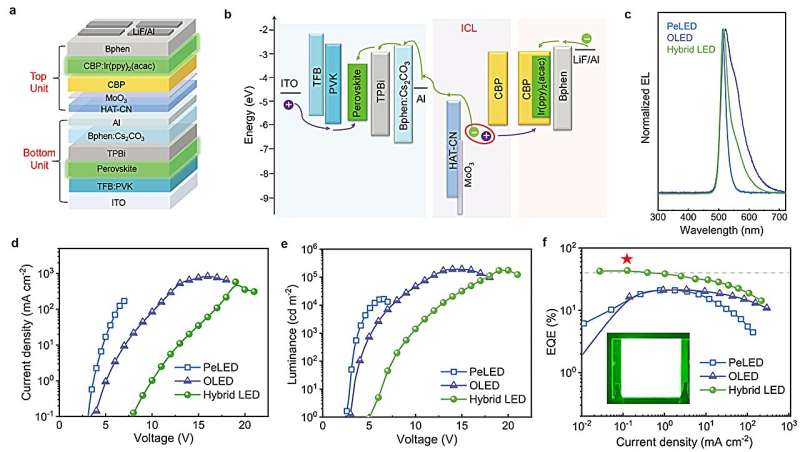This article has been reviewed according to Science X's editorial process and policies. Editors have highlighted the following attributes while ensuring the content's credibility:
fact-checked
peer-reviewed publication
trusted source
proofread
Scientists develop efficient and stable hybrid perovskite-organic LEDs with external quantum efficiency exceeding 40%

Tandem LEDs offer an effective way to integrate different light-emitting technologies for better display that meets Rec. 2020 color gamut standard. Now, scientists in China have developed a stable, efficient and high-color purity green LED with a tandem structure by combining perovskite LED and organic LED technologies.
The key to achieving this result is to design an efficient interconnecting layer with p-type interface doping that provides good opto-electric coupling and reduces Joule heating.
Light-emitting diode (LED), one of the core parts of display equipment, is required to fulfill the requirements of Rec. 2020 color gamut standard for next-generation display applications. Metal-halide perovskites have extremely narrowband emissions and easily tunable bandgaps, which are among the few kinds of emitters that can fully satisfy the Rec.2020 so far.
Fast advances in perovskite LEDs (PeLEDs) have been made in the past few years and the current external quantum efficiency (EQE) of PeLEDs have approached 30%, comparable to those of commercial organic LEDs (OLEDs).
However, the intrinsic instability of perovskites still casts a shadow over their practical applications. Combining highly color-purity perovskite emitters with other mature display technologies such as OLEDs to expand the display color gamut could be a shortcut towards commercialization for high-definition displays.
In a paper published in Light Science & Applications, a team of scientists, led by Professor Xuyong Yang from Key Laboratory of Advanced Display and System Applications of Ministry of Education, Shanghai University, China, and co-workers have developed a stable, efficient and high-color purity hybrid LED with a tandem structure by combining the perovskite LED and the commercial organic LED technologies to accelerate the practical application of perovskites.
PeLED and OLED with close photoluminescence peaks are selected to maximize photon emission without photon reabsorption and to achieve the narrowed emission spectra.
By designing an efficient interconnecting layer with p-type interface doping that provides good opto-electric coupling and reduces Joule heating, the resulting green emitting hybrid LED shows a narrow line width of around 30 nm, a peak luminance of over 176,000 cd m-2, a maximum external quantum efficiency of over 40%, and an operational half-lifetime of over 42,000 h.
More information: Lingmei Kong et al, Efficient and stable hybrid perovskite-organic light-emitting diodes with external quantum efficiency exceeding 40 per cent, Light: Science & Applications (2024). DOI: 10.1038/s41377-024-01500-7
Journal information: Light: Science & Applications
Provided by Chinese Academy of Sciences




















